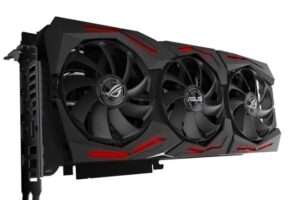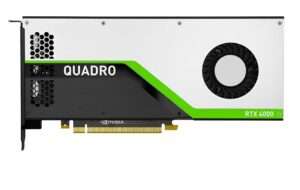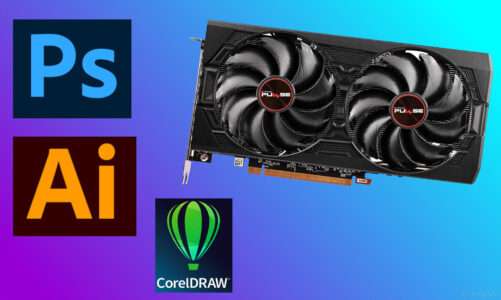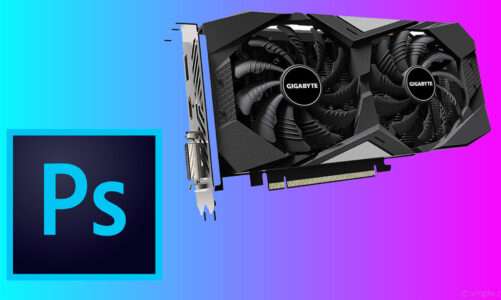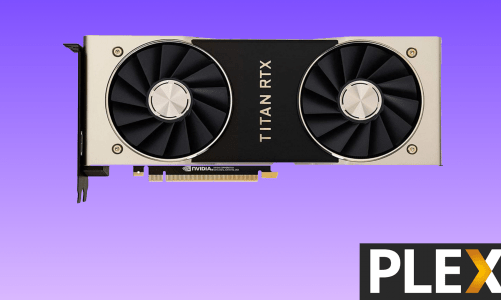Quick Navigation
GPU Republic is reader-supported. We follow a strict editorial process and put hours of research into testing, reviewing, analyzing & comparing the best products that we can find so you can make the most informed decisions. In the event you choose to buy something from one of the links on our site, we may make a commission at no extra cost to you. Whatever products we recommend, it’s because we truly believe in them, not because of the small commission we may receive. Please don’t buy any of these products unless you actually think that it would fit your needs.
By installing the best graphics card for 3D modeling and rendering, you can get the most out of your designing software. If your work consists of complex designing projects, then you cannot ignore the processing power of a graphics card. Having said that, not every graphics card is capable of rendering what’s on the mind of a 3D artist. You’ll need a powerful GPU to render those visual effects and multiple layers in a single file.
GPU rendering uses the processing power of your graphics card. The GPU rendering engines like Octane, V-Ray RT, Cycles, and FuryBall work great with dedicated graphics cards that have more VRam. Also, GPU rendering is becoming more popular and soon it will take over CPU rendering.
No doubt, Nvidia’s RTX GPUs are an ideal choice for 3D rendering and modeling. Thanks to ray-tracing abilities and enough CUDA cores that make the rendering process faster.
Although, you can go for high-end graphics cards from AMD like the RX 6800 XT or RX 6900 XT. But the GPU rendering engines are highly optimized for Nvidia GPUs, so having one would significantly affect the rendering times. Once the GPU rendering takes full control over CPU rendering, we might see engines with full support for AMD GPUs as well.
Quick Shopping Tips
- Skill Level & Budget: Before you buy any card, just ask yourself where you stand in the 3D modeling environment. If you are a beginner/hobbyist who is learning 3D modeling, then there’s no need to go after the premium cards. However, if you are a professional 3D artist who deals with commercial scale 3D projects, then you might find it worth it to go after the performance-based cards.
- AMD/Nvidia: You can pick between AMD and Nvidia cards at the moment. Most 3D rendering applications favor Nvidia cards due to their higher bandwidth. Nvidia’s Quadro series offers some of the most reliable options for professional content creators. But recently, the RTX 3090 and RTX 4090 are in greater demand compared to the Quadro series cards due to their more affordable price.
Similarly, the AMD’s RX 6000 series cards are packed with plenty of 3D rendering performance, but they also draw more power out of your PSU at the same time.
- VRAM: Also known as video memory, this is responsible for storing objects, geometry, and shapes. Technically, the VRAM is responsible for storing all the visual data that is shown on your screen. The more VRAM capacity you have, the more data your graphics card can store at a given time. If you are dealing with intense 3D environments in your projects, then it’s better to have graphics cards with a higher amount of VRAM to tackle loads of data.
- Memory Bandwidth: Apart from VRAM, memory bandwidth is another crucial factor to look at when shopping for a GPU to deal with 3D rendering tasks.
Memory bandwidth determines how fast the communication is between the CPU and GPU. For example, if you have a high-end CPU installed on your workstation, then it’s better to choose a higher bandwidth graphics card to keep up with the pace of the processor.
- ROP: Also known as “Render Output Unit”, this is hardware found in latest-generation graphics cards. This greatly helps in finalizing the rendering process while improving the communication between relevant buffers and local memory. Ampere and Ada Lovelace graphics cards from Nvidia offer superior ROP performance as compared to AMD RDNA 2 cards. You can get more advantages from ROPs if you constantly deal with 3D models that involve ray-tracing. This will allow you to create and customize 3D models with real-life lighting effects.
- Cores: The nature of cores on a GPU is similar to that of cores on a CPU. GPU cores are responsible for processing the visual data.
Nvidia refers to them as “CUDA cores” whereas AMD has named them “Stream processors”.
Generally, the more cores a GPU has, the faster it processes the data, hence improving the 3D rendering performance. A higher core count on a GPU usually leads to shorter rendering times.
Best Graphics Card for 3D Modeling
Here are some of our top considerations when it comes to picking the right GPU for your 3D modeling workstation:
Asus ROG STRIX GeForce RTX 2080Ti – A Future-Proof GPU for 3D Modeling & Rendering
Memory: 11GB GDDR6
Boost Clock Speed: 1665 MHz
Memory Interface: 352-bit
Memory speed: 1.4 Gbps
CUDA Cores: 4352
No doubt, the RTX 2080 Ti is a high-end graphics card with unparalleled 3D rendering performance. Thanks to the 4532 CUDA cores and higher clock speed shorten the rendering time of complex 3D environments from hours to minutes.
If you really want to enjoy the combined effect of ray-tracing and DLSS, then this is the right GPU for you. With ray-tracing features, you can put life into your 3D animations. And Nvidia’s DLSS technology makes sure you get the best frame rates possible without suffering from any lag.
The Asus RTX 2080 Ti is one of those GPUs that comes with a lot of memory bandwidth. In the case of this GPU, we have a bandwidth of 616 Gbps. This gives the RTX 2080 Ti a huge edge in faster data transfer. Moreover, the 11GB GDDR6 memory and clock speed of 1665 MHz make this future-proof for upcoming GPU-rendering engines.
If you want a graphics card for 3D rendering with more processing power, the RTX 2080 Ti might be your final bet. For high-end 3D Workstations, this GPU shows up as the best deal in the market. The only downside to this GPU is that it’s expensive, at least for now. In the coming months, prices of GPU might fall back and that would be an ideal time to save a few bucks.
RTX 2070 Super Founders Edition – Best GPU-Render Value
Memory: 8GB GDDR6
Boost Clock Speed: 1770 MHz
Memory Interface: 256-bit
Memory speed: 616 Gbps
CUDA Cores: 2560
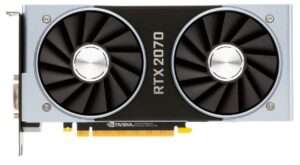
The Nvidia RTX 2070 Founder Edition is our first choice when it comes to dealing with complex architectural rendering tasks. This is one of those GPUs that sits in the budget range of the Nvidia line-up while offering the best possible performance.
RTX 2070 Founder Edition holds 2560 CUDA cores and a boost clock speed of 1770 MHz to render images faster as compared to GTX series cards. Core count matters a lot in 3D modeling, and Nvidia RTX 2070 fits perfectly in that equation.
On top of all, this GPU holds the power of ray-tracing. So, if you are dealing with 3D animations or scenarios where you need to render natural shadows and light, this GPU might be the right fit for you.
Finally, if you depend on GPU rendering engines to take care of your projects, going after a well-optimized GPU like RTX 2070 would definitely boost your rendering performance. It’s one of the best-rated mid-range graphics cards that delivers the right value in comparison to its price.
PNY NVIDIA Quadro RTX 4000 – Powerful 3D Modeling Graphics Card for Professionals
Memory: 8GB GDDR6
Boost Clock Speed: 1545 MHz
Memory Interface: 256-bit
Memory speed: 416 Gbps
CUDA Cores: 2304
Although this is the most powerful GPU from Nvidia, it lies a bit on the expensive side. However, with a higher price tag comes the real 3D rendering performance. Also, this GPU holds the title of being the first graphics card from Nvidia that was packed with ray-tracing capabilities.
The performance of Quadro RTX 4000 in creative applications like AutoCAD is not hidden from us. Indeed, this was one of the best graphics cards that were highly recommended by 3D modeling experts on different forums.
It might not be wrong to say that this is one of those GPUs that were highly optimized to deal with GPU-rendering engines. In several benchmarks, the Quadro RTX 4000 has shown an ideal boost in anti-aliasing and rendering speeds.
Also, the Quadro RTX 4000 packs enough cores (2304 CUDA cores) and clock speed to shorten the rendering times. If you are working in an intense 3D environment where there is more involvement of lights and shadows, you can benefit from the ray-tracing power of this GPU.
We highly recommend going after Quadro RTX 4000 if you need a powerful 3D modeling graphics card for your workstation. It holds more power, but at the same time, it’s one of the low-power consuming graphics cards in the RTX family.
ASUS GeForce RTX 2060 Overclocked – Best Budget 3D Workstation Graphics Card
Memory: 6GB GDDR6
Boost Clock Speed: 1785 MHz
Memory Interface: 192-bit
Memory speed: 1.4 Gbps
CUDA Cores: 1920
The RTX 20 series is dominating the GPU market whenever we look for the top-performing graphics card on a low budget. Keeping apart the RTX 2080 Ti, which is still the most expensive GPU in the RTX 20 line-up, we will head for the RTX 2060. And this GPU is tuned by Asus at a higher clock speed and dual fans for efficient cooling.
Now let’s talk about the performance of the Asus RTX 2060 in the 3D content creation department. To be honest, we’ve found this GPU performing somewhat similar to the RTX 2070 Founder Edition.
Although the Asus RTX 2060 packs less memory and fewer CUDA cores than the RTX 2070, there isn’t much difference in the rendering time. If you swap 2GB video ram and some CUDA cores from an RTX 2070 GPU, you can expect it to perform like Asus RTX 2060, there isn’t much difference in both GPUs apart from the design.
So if it’s about dealing with geometry, textures, shapes, visual effects, or animations in a 3D environment, this GPU can handle everything without any hassle. This graphics card is ready to handle complex 3D workloads and scenarios, thanks to Nvidia’s ray-tracing and DLSS capabilities.
It is one of those GPUs that sit perfectly on a sweet spot between price and performance. If you can invest $300 more, you can get a better-performing graphics card like the Nvidia RTX 2080. But if you don’t want to go that far, then this GPU is enough to deal with complex 3D applications.
AMD XFX RX 570 – A Cheaper Graphics Card to Deal with 3D Modeling Engines
Memory: 8GB GDDR5
Boost Clock Speed: 1286 MHz
Memory Interface: 256-bit
Memory speed: 7000 Mbps
Stream Processors: 2048
The only graphics card on our list from AMD that is not only cheaper but also best for beginners who have just started to interact with 3D Workstations and applications. The RX 570 is equipped with AMD’s favourite Polaris GPU architecture with 8GB of GDDR5 memory on a 256-bit interface.
Apart from being an entry-level graphics card, the XFX RX 570 bears enough GPU cores to be a good performer in 3D content creation. And with 2048 stream processors, this graphic proves itself for being the right contender in the list of best 3D modeling GPUs.
Also, the reason behind its considerable performance is because of its 256-bit interface and boosted clock speed up to 1286 MHz. Now, this is nothing compared to RTX GPUs from Nvidia, but these specs meet the minimum requirements of most GPU-rendering engines available in the market.
If you are looking for a low-budget graphics card to render projects up to 1080p resolution, then the XFX RX 570 truly fulfils your needs. But rendering scenarios over 1080p would take a long time and patience with this GPU. And for higher resolution rendering, we recommend you to stick with Nvidia’s RTX series.
This graphics is ideal for beginner level 3D workloads where you don’t need high-end features like ray-tracing and DLSS.
Why Do You need a GPU for 3D Modeling or Rendering?
It is because modern 3D rendering applications have become complex and use more system resources apart from just the CPU. Once that complex workload is shifted from your CPU towards your GPU, the rendering becomes faster and smooth.
The latest rendering software allows you to model environments or scenarios in real-time. And for a lag-free experience, it is important to install the most compatible 3D rendering GPU in your system.
CPUs have fewer cores and cannot keep up with the heavy workload thrown upon them by the 3D modeling software. GPUs on other hand have hundreds or even thousands of cores to divide the most complex scenarios at a single time.
3D modeling GPUs come up with more VRam, bandwidth, and processing power to deal with polygons thrown over by software. A higher level of graphical work can only be handled with the help of the best workstation graphics cards.
Things to Consider Before Buying a 3D Modeling Graphics Card
Here are some important factors to keep in mind:
Which is Better? Nvidia or AMD
Nvidia cards are expensive but offer the best value in terms of efficiency and power. Especially, the RTX and Quadro Series graphics cards from Nvidia are ideal for 3D modeling and rendering projects. AMD on the other side makes graphics cards that are cheaper in price but lack high-end features like ray-tracing and DLSS.
We all know the efforts and results that features like ray-tracing and DLSS have put into modern 3D games. Unless AMD GPUs are equipped with high-end features that take over Nvidia’s ray-tracing and DLSS, we prefer staying with Nvidia GPUs for faster and more effective rendering.
Video Memory
Video memory or VRam of a graphics card is responsible for storing textures, images, and shapes for a temporary period. The more VRam a GPU has, the more data it can store inside it. Also, consider the GPU that has more memory bandwidth apart from just more memory. Memory bandwidth is a metric that determines how fast the data is transferred between the VRam and GPU.
Cores
The more computing cores a GPU has, the faster would be its rendering performance. Nvidia uses the code CUDA cores whereas AMD notifies them by stream processors.
Clock Speed
Each core in a GPU has a specific clock speed at which it operates. Higher clock speed shortens the rendering time of a GPU. There are two clock speeds at which a GPU operates, namely the base clock speed and the boost clock speed.
When a GPU is under heavy load, it can achieve a boosted clock speed for better performance. You can also manually overclock a GPU with the help of software for better performance.
Budget
The graphics cards that are meant for 3D workloads come lie in a different price range. If you are a professional who deals with complex 3D projects, then you can go with a high-end GPU like the RTX 2080 Ti. If you are a freelancer dealing with mid-level 3D modeling workloads, then RTX 2070 or 2060 would be a better choice. For beginners, it’s better to stick with lower-end graphics cards like XFX RX 570 or GTX 1660 Ti from Nvidia.

Hi, I’m the author and founder of this blog. I have more than 10 years of experience in the industry. Throughout my journey I’ve tested and reviewed hundreds of graphics card for custom PC builds. I believe my knowledge and experience will help you choose the card that really falls to your needs and budget.

